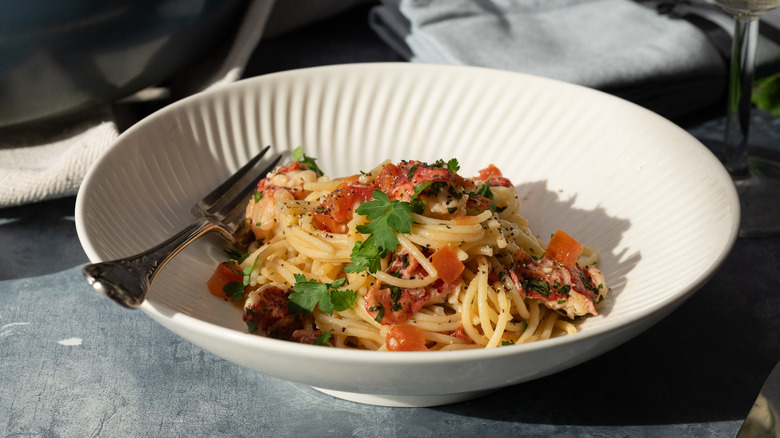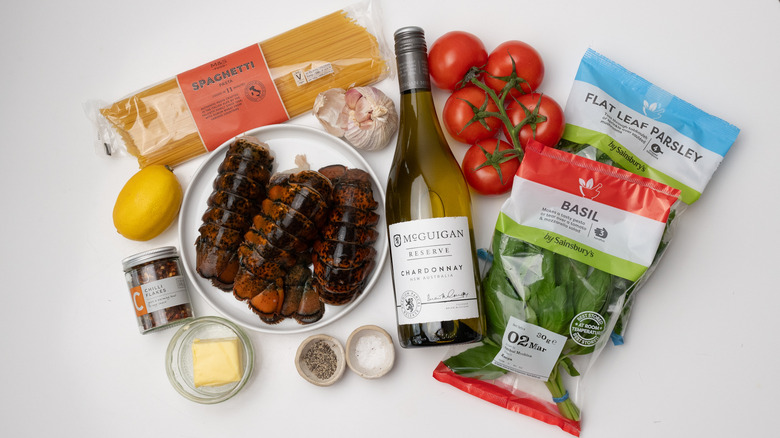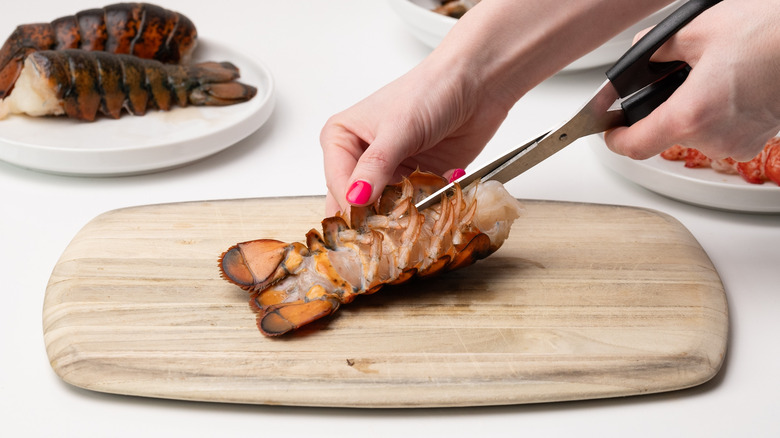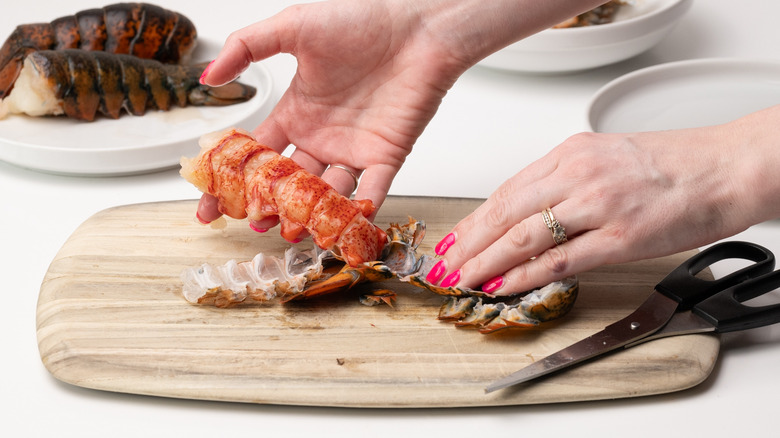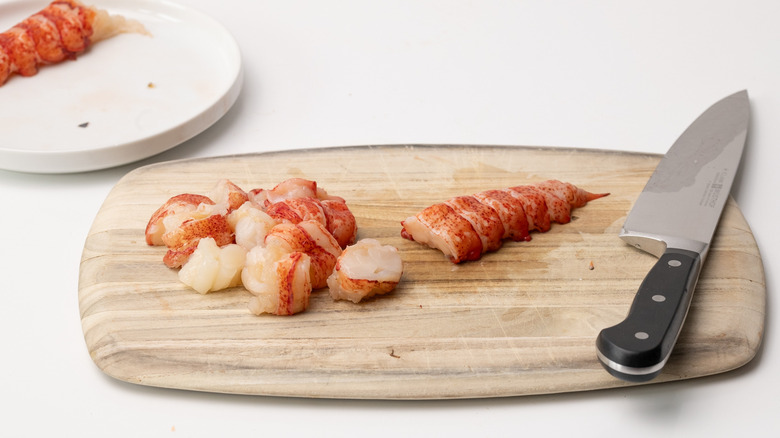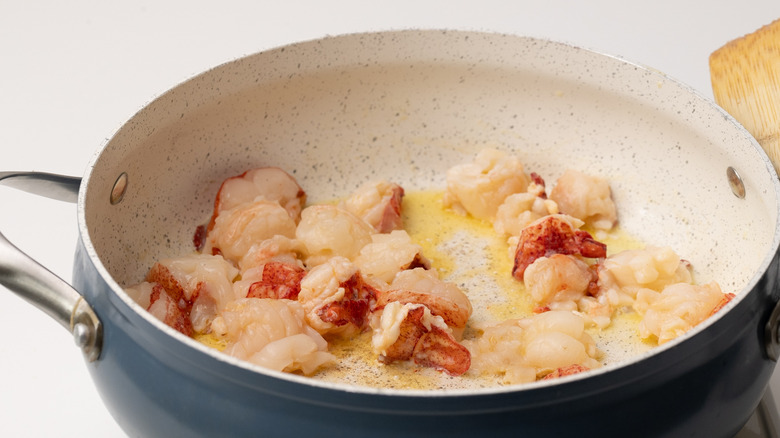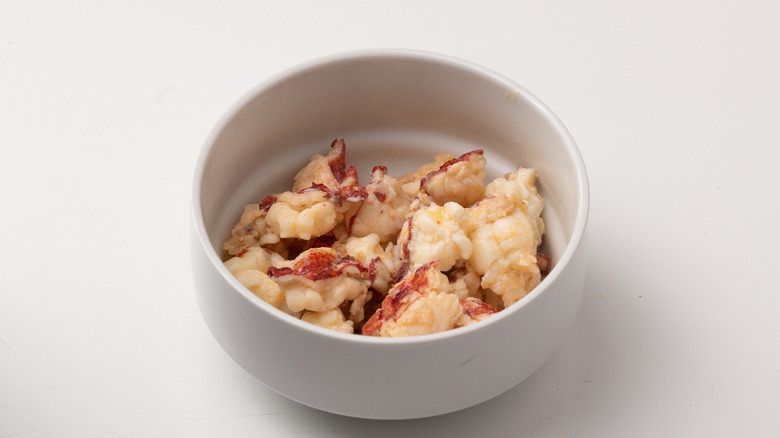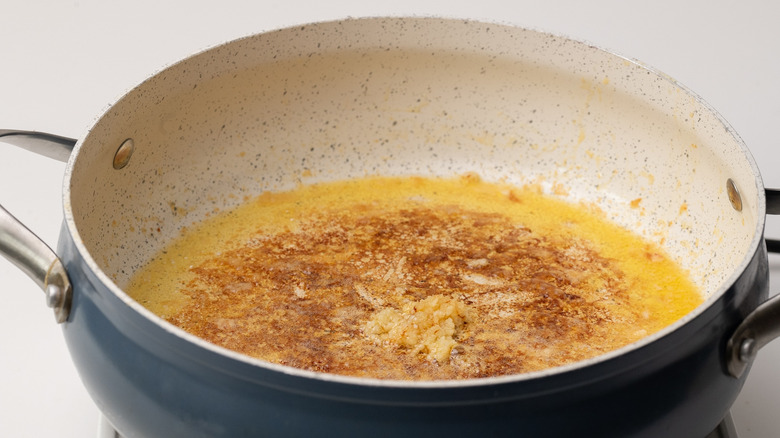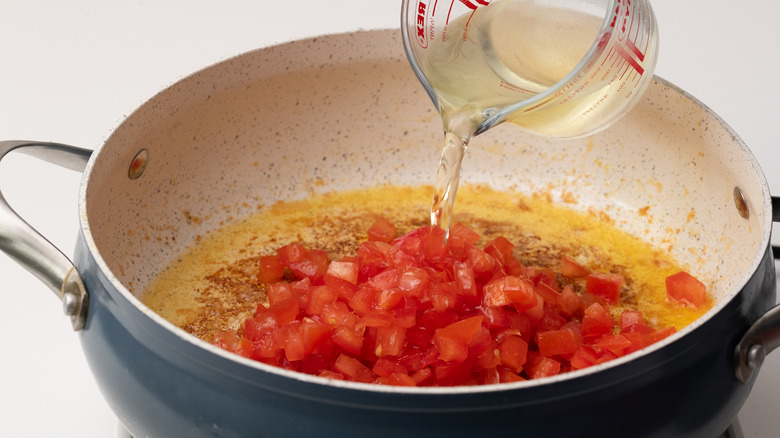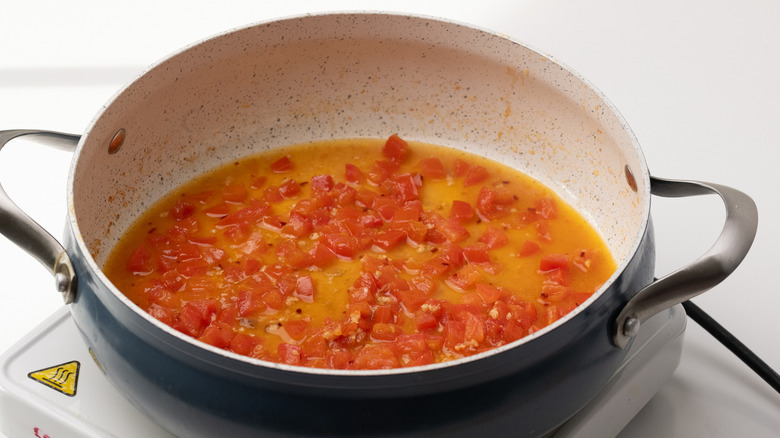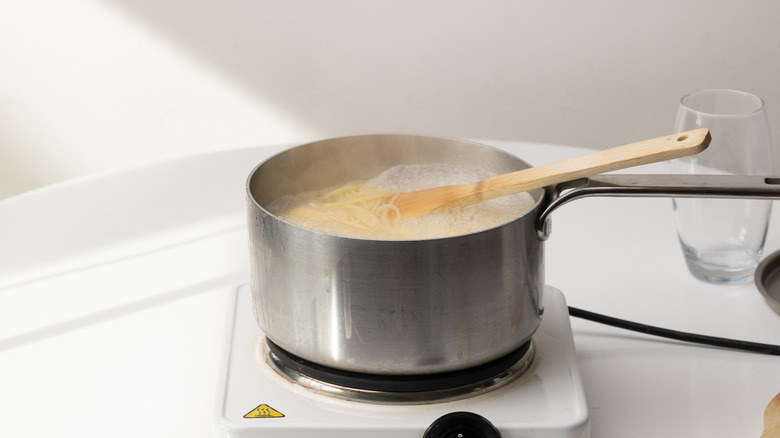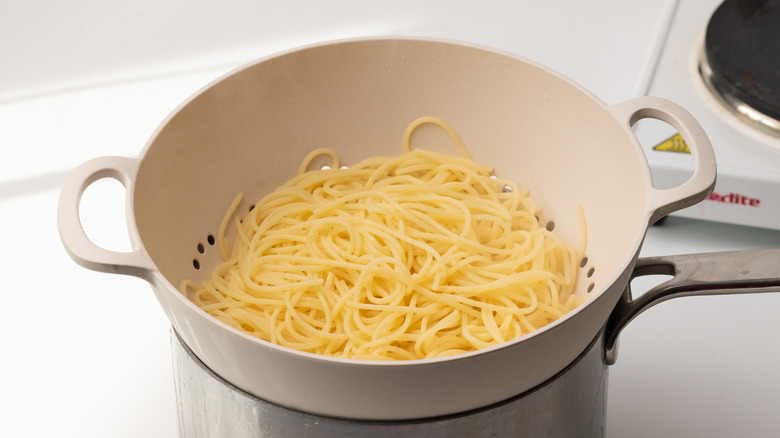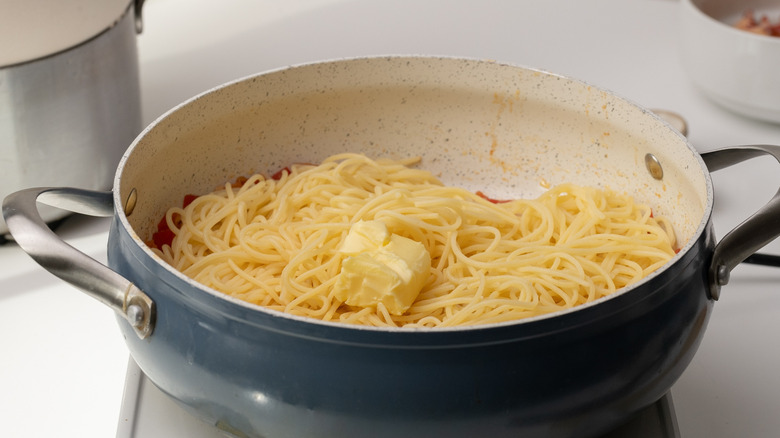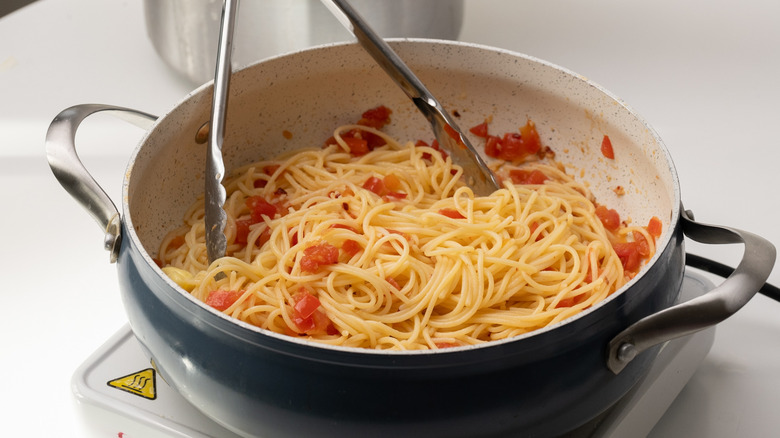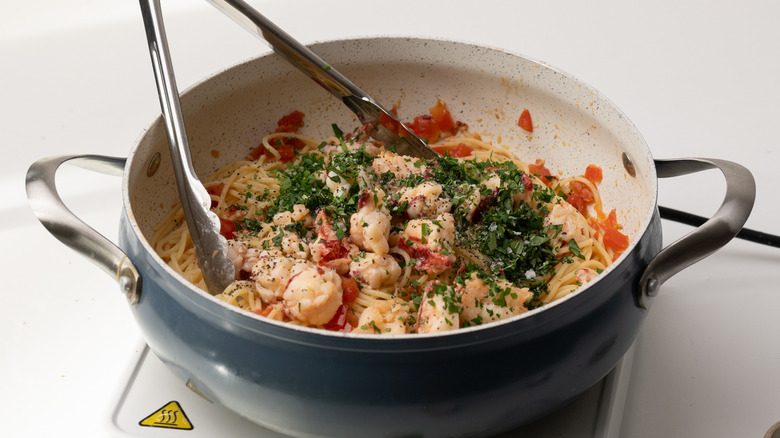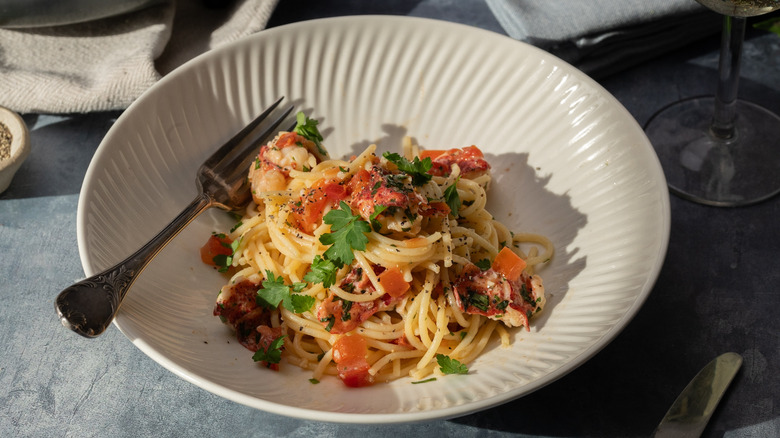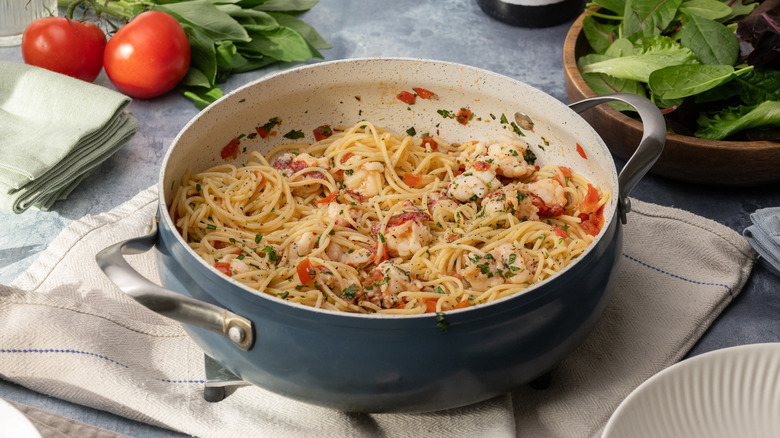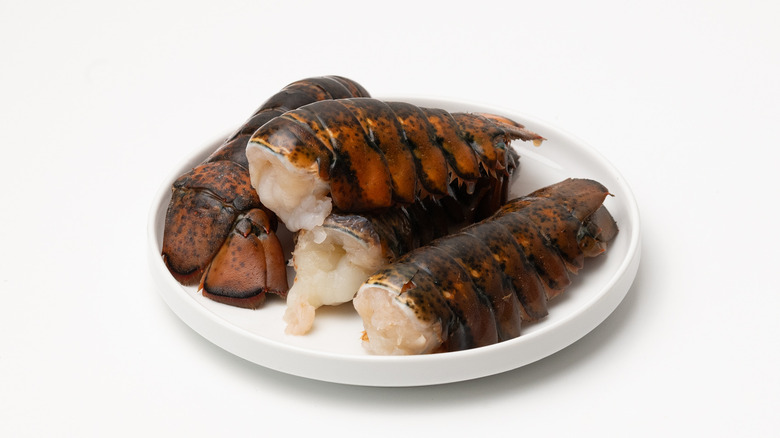Buttery Lobster Spaghetti With White Wine-Tomato Sauce Recipe
If asked to think of a luxury food item, it's likely that lobster will be near the top of anyone's list, and with good reason. This tender, sweet, and succulent seafood is a delight to eat and is often costly to come by — however, this wasn't always the case. In previous centuries, this now-expensive delicacy was used to feed prisoners since it was so plentiful and undesirable. Nowadays, this popular social-climbing crustacean is most often found on the menus of fine dining restaurants or those which specialize in seafood, and it's safe to say that most people view lobster in a much more esteemed light.
Due to its present-day reputation as a luxury food item, it can feel a little intimidating taking on the task of preparing and cooking lobster at home. This buttery lobster spaghetti with white wine-tomato sauce recipe, created by Tasting Table recipe developer Jennine Rye, is an ideal dish for anyone who loves seafood and home cooking. This recipe will help you to make the most out of lobster, guiding you through the preparation of this protein-rich seafood and so you can pan fry it to perfection in plenty of butter. Served in a light and simple white wine and tomato sauce, and finished off with a sprinkling of fresh herbs and lemon juice, this is a dish worthy of any fine dining restaurant, and you can enjoy it in the comfort of your own home in less than an hour.
Gather the ingredients for this buttery lobster spaghetti with white wine-tomato sauce
To begin this recipe, you will want uncooked lobster tails, butter, a garlic clove, tomatoes, white wine, chili flakes, spaghetti, lemon juice, fresh parsley, fresh basil, and salt and pepper.
Step 1: Cut the lobster shell
Using a sharp pair of scissors, cut the shell down both sides of the underbelly of the lobster tails.
Step 2: Remove the lobster meat
Peel the shell back and then carefully pull out the lobster meat, discarding the shells or setting them aside for another use.
Step 3: Chop the lobster meat
Slice the lobster meat into roughly 1-inch-sized pieces.
Step 4: Melt the butter
Heat up 2 tablespoons of butter in a large pan over medium heat.
Step 5: Cook the lobster
Add the lobster meat to the pan and fry for 3 to 4 minutes, until just cooked through.
Step 6: Set the lobster aside
Remove the lobster from the pan and set aside.
Step 7: Fry the garlic
Add the crushed garlic to the pan and cook for 30 seconds.
Step 8: Add tomatoes, wine, and chili flakes
Add the chopped tomatoes to the pan along with the white wine and a pinch or two of chili flakes, depending on your spice preference.
Step 9: Simmer
Let the mixture simmer for 10 minutes until the wine has reduced and the tomatoes are soft.
Step 10: Cook the spaghetti
Meanwhile, bring a large saucepan of salted water to a boil and add in the spaghetti. Cook for 8 to 10 minutes, or according to package instructions, until al dente.
Step 11: Drain the spaghetti
Drain the spaghetti, reserving 1 cup of pasta water.
Step 12: Add the spaghetti to the tomatoes
Add the cooked spaghetti, along with 2 tablespoons of butter, to the pan with the wine and tomatoes.
Step 13: Mix with pasta water
Mix to combine everything and add enough of the pasta water to form a glossy sauce on the spaghetti. You may not need the entire cup of pasta water.
Step 14: Add the lobster, herbs, lemon juice, and seasoning
Toss in the cooked lobster, fresh lemon juice, parsley, basil, and salt and pepper to taste.
Step 15: Serve
Serve immediately, topped with a few more fresh herbs if desired.
How can I switch up this lobster spaghetti?
There are a few ways you can switch up this seafood pasta dish, depending on personal preference or possible dietary restrictions. This dish is a wonderful option for any gluten-free diners, and to make it safe for anyone with celiac or gluten intolerance, all you need to do is switch out the spaghetti for a gluten-free variety. Just make sure to cook it only until it reaches an al dente state; any more than that and the pasta will begin to fall apart. To adapt this dish for a dairy-free diet, simply switch out the butter for a dairy-free variety, or another cooking oil such as olive oil. And, for those who choose to avoid alcohol, this recipe can be made instead with a simple stock in place of the white wine. Chicken or vegetable are always great options, or for a more fishy finish you could use a fish stock.
To add even more decadence to this luxurious meal, add some shrimp or clams to the pan along with the lobster for a serious seafood celebration. Or, for more nutrients and color, spinach can be added to the pan along with the cooked spaghetti, just allow it to wilt for a minute or two before serving up the finished dish. And, for a different finish, you can always play around with the herb varieties used in this recipe.
What can I do with leftover lobster shells?
Lobster is definitely one of the more expensive items of food that you'll find in the supermarket or at your local fishmongers, so, it is definitely worthwhile to use every aspect of this luxury ingredient. Many people will throw away the shell of the lobster once they have removed the meat, considering it to be a waste product that cannot be eaten. However, the shell of a lobster is actually packed full of that unique rich and sweet meaty flavor, so it is well worth keeping it to make a lobster stock, or to use for the base of another delicious dish.
If you aren't ready to cook with it right away, you can also easily freeze lobster shells, then just remove them from the freezer when you are ready to create your home cooked broth or gravy. To make a simple stock, add the picked-clean lobster shells to a large saucepan along with plenty of water, some root vegetables such as onions and carrots, and a few bunches of herbs. The longer it simmers the richer the flavor of the resulting stock, and this can then be used to make delicious risottos, chowders, or lobster bisque.
Buttery Lobster Spaghetti With White Wine-Tomato Sauce Recipe
At-home date nights just got a whole lot more exciting thanks to this buttery lobster spaghetti recipe, which comes with a decadent white-wine tomato sauce.
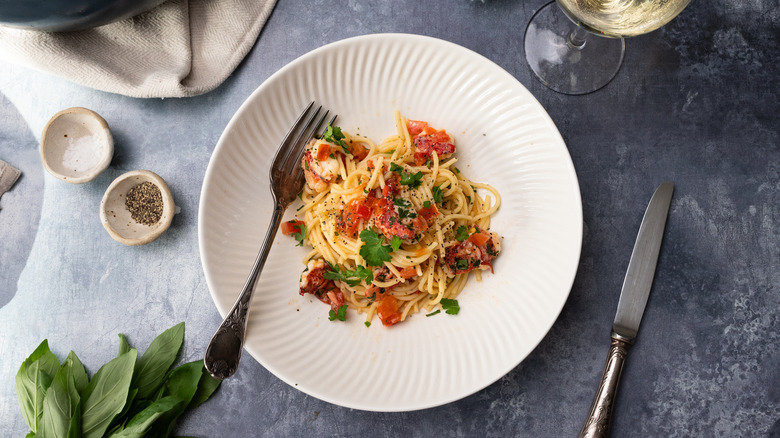
Ingredients
- 4 uncooked lobster tails
- 4 tablespoons butter, divided
- 1 large garlic clove, crushed
- 1 cup tomatoes, deseeded and diced
- ½ cup white wine
- 1-2 pinches chili flakes
- 10 ounces uncooked spaghetti
- 1 tablespoon fresh lemon juice
- 1 tablespoon chopped fresh parsley
- 1 tablespoon chopped fresh basil
- salt, to taste
- pepper, to taste
Directions
- Using a sharp pair of scissors, cut the shell down both sides of the underbelly of the lobster tails.
- Peel the shell back and then carefully pull out the lobster meat, discarding the shells or setting them aside for another use.
- Slice the lobster meat into roughly 1-inch-sized pieces.
- Heat up 2 tablespoons of butter in a large pan over medium heat.
- Add the lobster meat to the pan and fry for 3 to 4 minutes, until just cooked through.
- Remove the lobster from the pan and set aside.
- Add the crushed garlic to the pan and cook for 30 seconds.
- Add the chopped tomatoes to the pan along with the white wine and a pinch or two of chili flakes, depending on your spice preference.
- Let the mixture simmer for 10 minutes until the wine has reduced and the tomatoes are soft.
- Meanwhile, bring a large saucepan of salted water to a boil and add in the spaghetti. Cook for 8 to 10 minutes, or according to package instructions, until al dente.
- Drain the spaghetti, reserving 1 cup of pasta water.
- Add the cooked spaghetti, along with 2 tablespoons of butter, to the pan with the wine and tomatoes.
- Mix to combine everything and add enough of the pasta water to form a glossy sauce on the spaghetti. You may not need the entire cup of pasta water.
- Toss in the cooked lobster, fresh lemon juice, parsley, basil, and salt and pepper to taste.
- Serve immediately, topped with a few more fresh herbs if desired.
Nutrition
| Calories per Serving | 517 |
| Total Fat | 13.8 g |
| Saturated Fat | 7.7 g |
| Trans Fat | 0.0 g |
| Cholesterol | 221.0 mg |
| Total Carbohydrates | 56.5 g |
| Dietary Fiber | 3.0 g |
| Total Sugars | 3.3 g |
| Sodium | 719.5 mg |
| Protein | 34.7 g |
